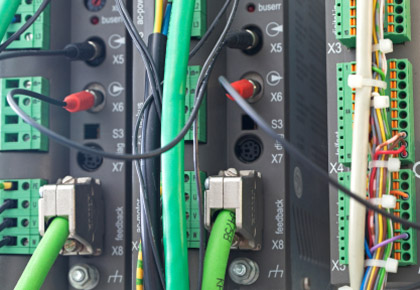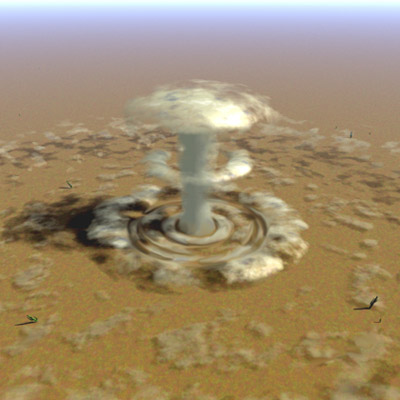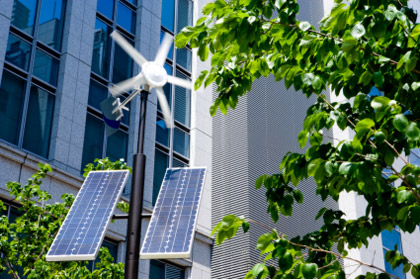National Security & Distributed Power Generation
Nine years ago on what was otherwise a regular summer day in Northern Ohio, a high-voltage transmission line sagged because of the high current passing through it and clipped an untrimmed tree branch nearby. Within two hours, large portions of the Northeastern United States and neighboring Canada were without electrical power. Although the catalyst for this event was nothing more dramatic than a sagging line, the resulting blackout was huge – more than 500 generating units were knocked offline and 55 million people lost power, many for more than one week. The ultimate cost was estimated at $6 billion and at least 11 lives.
THE 2003 BLACKOUT SERVED AS AN ALARMING REMINDER THAT THE GRID IS FRAGILE & UNPREDICTABLE. Problems in the system exist because the North American power grid, as it exists today, is largely a patchwork entity pieced together throughout this past century. What began as a collection of islanded electrical grids gradually grew larger, added transmission lines in ever-higher voltages to facilitate bulk power delivery and eventually covered most of the continent. The resulting collected equipment – sometimes referred to as the largest machine in the world – relied entirely on large, centralized power plants located close to fuel sources and an enormous distribution system of transformers and high-voltage lines to deliver power to end-users. Consequently, the collective infrastructure supporting the grid today is extremely old and outdated. Large portions were built in the 1950s and have not been upgraded since.
In 2003, the fragility of the ad hoc and aging grid enabled the not-uncommon event of a power line brushing up against an object to trigger cascading outages throughout the system as power swings and voltage variances tripped generators and relay systems across the continent. Although events of this size and duration are rare occurrences, grid instability and outages are common and represent a severe economic problem in the United States today. Hewlett-Packard estimates that even a 15-minute outage at one of its chip-manufacturing plants carries a cost of $30 million. Nationwide, the economic costs incurred from blackouts approaches $120 billion annually.
Economics aside, the U.S. government, military and intelligence assets, along with critical infrastructure the country relies on for survival – water, sewage, healthcare, communications, agriculture, transportation and finance (among others) – depend on the consistent and uninterrupted supply of electricity from the grid. More worrying, while the predictable problems the grid has faced to date have been costly, far more serious and less predictable threats confront the current centralized power grid network. These are threats stemming from low-probability, high-cost events, which generally fall into three categories.

© iStockphoto.com/cheyennezj
THE FIRST SET OF NATION-LEVEL GRID SECURITY THREATS ARE THOSE POSED BY CYBER ATTACKS. As the electricity industry has moved towards more efficient ways of managing power generation and distribution, it has come to rely heavily on internet-connected Supervisory Control and Data Acquisition (SCADA) systems. In addition to SCADA systems, approximately 85 percent of all relays are now digital as are remote terminal units, circuit breakers, static var compensators, capacitor bank controllers, demand response systems, meters and plant control systems.
Highly susceptible to attack, U.S. power grid systems – and other critical infrastructure – are probed daily by actors ranging from states (notably China and Russia) to hacking organizations and even individuals. These intrusions have not yet resulted in any catastrophic attacks or grid failures in North America. However, cyber-attacks have knocked grids offline in countries with similarly fragile grids, and security experts largely agree that a number of hostile actors could shut down portions of the grid if they chose to do so. Satellite imagery of power plants and transformers can easily be located online, along with databases of unsecured SCADA systems and other pieces of sensitive information.
While security is a critical component of any grid, the centralized bulk-power network in the United States exacerbates these glaring security risks. Hackers, terrorists or other groups need only target a single high-voltage transformer or power plant in order to cause large power outages and grid disruptions. Furthermore, as the 2003 blackout demonstrated, even minor disruptions, if well targeted, can cause cascading failures throughout large portions of the electrical grid. Because the replacement timetable for much of the large-scale equipment is months or even years, intentionally-caused grid outages raise the specter of extremely long duration blackouts.
A SECOND LOW-PROBABILITY, HIGH-COST EVENT INVOLVES A PHYSICAL ATTACK ON THE GRID. A wide range of vulnerabilities exist within the grid to simple physical attacks. Some of the most vital equipment in the grid is highly susceptible to even small explosives and high-powered handheld weapons. Similar to a coordinated cyber-attack, a synchronized physical attack on multiple transformers across the country could result in power outages that would last for months and cripple the nation’s economy and military capabilities.
FINALLY, AN ELECTROMAGNETIC PULSE (EMP) EVENT IS THE GREATEST POTENTIAL THREAT to a fragile and centralized grid, originating either from a natural geomagnetic disturbance or intentionally created by a high-altitude nuclear detonation. Although these two threats are distinctly different, the risks they pose are largely the same. Solar flares – massive bursts of plasma periodically emitted by the sun – can induce extreme electrical currents, which are channeled by high-voltage power transmission lines connecting bulk-power systems that span the entire country. As these voltages surge through power lines, they can overload and burn out power transformers, thus causing permanent damage to electrical infrastructure.
Two large geomagnetic superstorms have occurred in the past century and a half – one in 1859 and the other in 1921. Both were before the construction of the modern electrical grid, which grows increasingly more vulnerable to these events with time as more and higher voltages of transformers and transmission lines are added to the grid. If a solar event equivalent to the 1859 storm occurred today, there is a significant chance that it would knock out a large portion of all electric grids in the Northern Hemisphere for a period of months or longer.

© iStockphoto.com/Elerium
An EMP originating from a nuclear detonation would have a much more intense effect but one probably localized to the Continental United States. Even discounting the chances of another Carrington-style solar storm occurring in the near future, the nuclear EMP vulnerability is widely understood and has been publically described by potential adversaries, including the regimes in Iran and North Korea.
The collateral effects of a power outage caused by any of the events described above have the potential to be catastrophic. The 2003 blackout was resolved quickly because repair crews and spare equipment could be brought from beyond the edge of the outage and because the equipment necessary to repair the problem was easily obtainable. In the case of a large event affecting most of the country and destroying difficult-to-replace equipment, the blackout itself would cripple repair efforts. This type of event has the potential to devastate the U.S. economy and carry a massive death toll.
TODAY, PEOPLE OF THE UNITED STATES ARE ENTIRELY DEPENDENT ON ELECTRICITY FOR SURVIVAL. Without power, virtually all commerce would stop within seconds. Telecommunications would become nearly impossible after a few hours. Water supplies in most cities would last only for hours as electric pumps stopped. Food would become difficult to obtain within a few days. Most importantly, in a continent-size blackout, systems needed to resupply diesel emergency response generators would be unavailable, meaning the emergency generators fueled by nonrenewable sources would not last more than a few days either.
One way to substantially reduce the risk of wide-scale power outages is to modernize and decentralize the North American electric grid. The grid as currently conceived is both interdependent and vulnerable. It is not, however, difficult to conceptualize a system far more decentralized and, consequently, less vulnerable to catastrophic long-term outages. Such a distributed model would enable and encourage widespread integration of smaller power sources closer to end-users – including renewable power options.
CUBA OFFERS A CASE STUDY IN THE ABILITY OF DISTRIBUTED GENERATION TO BOOST GRID RESILIENCY AND SECURITY. Throughout the last century, Cuba achieved 95 percent electrification using a centralized grid fueled by a system of large fossil fuel power plants. However, the system was brittle and old – much like the American grid today. As recently as 2005, structural inefficiencies in the plants and events, including natural disasters, left the Cuban people suffering more than 200 days of blackouts. Yet by 2008, this number had fallen to zero as a result of a massive program to decentralize power distribution across the country. By adding thousands of microgenerators and backup generators around the country, the Cuban government cut its reliance on centralized power plants while simultaneously increasing resilience of the grid in the event of outages. When disasters did strike, the decentralized generation system maintained critical services and islands of operation throughout the country while service was restored.
Expanded to a much larger scale, the type of decentralization Cuba implemented could help to reduce U.S. vulnerability to wide-scale and long duration outages. A large part of the vulnerability of the current power system in the U.S. is caused by centralization – relying on massive power plants and tens of thousands of miles of high-voltage transmission lines to move power from the point of generation to the point of use. When a problem arises in one portion, the interconnected nature of the grid creates potential for the type of massive outages and cascading failures that proved so problematic in 2003. With a distributed grid network, however, smaller assets are deployed around the country.

© iStockphoto.com/t_kimura
During the 2003 blackout, for instance, Kodak’s factory in Rochester, New York, escaped unscathed simply by having its own onsite power units. Ensuring critical institutions and infrastructure, such as military assets, hospitals, police stations, financial institutions, industrial plants, water and sewage systems, can generate power from renewable sources that will be available during a crisis is only common sense. However, to be economically viable, institutions investing in this type of renewable and localized generation must be able to sell their power back to the grid when not in crisis.
Beyond the benefits of localized power generation in crises, a decentralized system can help to prevent crises entirely because, when power is produced closer to end-users, the need is reduced for high-voltage transformers and transmission lines. A city with thousands of generators – rooftop solar, city cogeneration and so forth – contributes far less to a cascading failure and is capable of providing “edge” capability to facilitate restoring regional grids after a large scale failure.
A DECENTRALIZED SYSTEM ALSO HAS ADVANTAGES BEYOND THOSE ACCRUING TO NATIONAL SECURITY. First, a system that permits entrepreneurs to sell power back into the grid would act as a petri dish for innovation. Ending American Bell Telephone Company’s monopoly in 1984 opened up the path for the telecommunications revolution, which resulted in cell phones, the public Internet and all that followed. Removing the utility companies’ monopoly on power generation and creating a distribution system that can facilitate decentralization could lead toward something similar in the electricity generation industry.
Second, while decentralized power generation is less likely to benefit from economies of scale realized by massive generators, there will be lower transmission losses and peak load inefficiencies. Currently between 10 and 20 percent of energy generated in the United States is lost due to transmission inefficiencies, and the cost of electricity is increased because of problems involved with generating and supplying peak load. Generating power closer to point of usage eliminates much of the transmission loss, and variegated generation has the potential to significantly reduce peak load problems.
TWO MAJOR OBSTACLES EXIST TO MOVING TOWARD A MORE DECENTRALIZED SYSTEM. The first involves physical infrastructure; the second, politics. In regard to the first, the current grid system evolved throughout the course of a century. Much of the most expensive equipment is at least one-half century old. Even if it saves money in the long run, updating hardware is expensive in the near term. The second problem is private companies that currently own the grid, for the most part, enjoy government granted monopolies. In this system, seldom is there much benefit to investing in a system that would support potential competitors. In short, the expense of change would likely disadvantage both the companies that currently hold monopolies and the local governments that regulate them.
NEVERTHELESS, THE CURRENT SYSTEM OF POWER GENERATION DRASTICALLY NEEDS TO BE OVERHAULED AS AS MATTER OF NATIONAL SECURITY. Centralized power generation systems are not only more inefficient and expensive but also more vulnerable to a range of natural and man-made threats. Granted, while the switch to a distributed network will not make the grid invulnerable to disruption, it will go a long way towards ensuring grid resiliency. Response and recovery from a critical grid outage event can occur in a timely manner at the lowest possible cost in both money and human life.





























